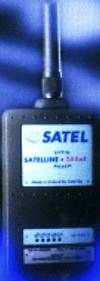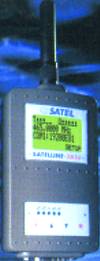

Use of wireless technologies such as DECT and GSM is growing more rapidly than the traditional fixed copper line telecommunication. Not only are base stations and networks easier and less costly to roll out, but they are infinitely more flexible. GSM provides for total mobility in terms of reception while a DECT telephone system can be simply relocated through moving the receiver/transmitter.
This same phenomenon of wireless technology replacing traditional cable is today impacting on the process control and other industries. Instead of costly cable runs, wireless transmitter and receiver systems can be rapidly and cost-effectively installed, and changes to the plant layout do not require new cable installation, the radio modems being moved along with the plant they monitor or control. Apart from in-plant use, the wireless solution is an ideal way in which factory data can be made accessible in realtime to management located in a different building or even a remote site, at distances of up to 40 km.
The wireless solution
At the forefront of this new industrial wireless technology is a Finnish company called Satel Oy (Satel). Satel was founded in 1986 by a group of engineers with a deep knowledge of wireless data communication devices (remember that Finland is also home to Nokia). Its focus was on the development and manufacture of radio modems designed for wireless data communication. These radio modems - of which Satel has released 20 different types since 1987 - can be used in a wide range of applications including industrial automation and process control, monitoring and control of energy/water systems, and traffic control. They can be used in both mobile and fixed applications and even in the case of the latter can be redeployed with only new power cabling required.
By 2001 the turnover of Satel had increased to some Ç8 million, more than 80% of its income being from export sales. The company has virtually doubled its turnover since 1998 and has almost trebled the production volume to 20 000 units per year. In excess of Ç2 million has been invested over the last three years in new business premises, improved production facilities and R&D (over Ç0,5 million). Satel recently achieved certification to the new ISO 9001:2000 standard, this covering its design, manufacturing and sales activities.
Despite its huge success Satel employs a modest 45 people in Finland with some half of these being involved in development. Sales are conducted through a worldwide network of distributors located in 30 countries from regions such as North America to the Far East. These distributors are currently active in more than 40 countries. Satel prides itself on the fact that its appointed distributors have a common denominator - 'solid experience and impeccable professional expertise in the field of wireless data communication'.

Products offered
In terms of its product lines, Satel operates in two main business areas, namely wireless data transfer and wireless alarm transfer. In terms of wireless data transfer the SATELLINE range of radio modems currently accounts for about 65% of sales. For industrial applications, the most common and versatile products are the SATELLINE 3AS and 3ASd, the transmitter power here allows communication over distances in excess of 10 km. The 3AS range is compatible with the three most widely used data interfaces, namely RS232, RS422 and RS485 (lower spec products with just an RS232 interface are also available). The 3ASd differs only in that it is equipped with a user-interface LCD display and can be configured without a terminal (PC) using its push-button controls. The display on the 3ASd can also be used for testing of the operating condition of the radio connection with any other radio modem. These units weigh a mere 250 g, can operate with a 12 or 24 V power supply, and consume 1,8 or 6,0 VA power (receive or transmit mode). In terms of physical size the 3AS devices are similar in size to first-generation cellphones. These pocket-sized dimensions make them truly portable. Data transmission rates can be up to 19,2 Kbps at a radio frequency between 380 and 470 MHz.
While the standard 3AS has a power output of between 10 mW and 1 W (depending on the distance between source and receiver), the top of the range product, the 3AS Epic, operates at up to 10 W and can communicate reliably over distances in excess of 40 km. The Epic is compatible with the same range of interfaces and is also programmable in the same way as the 3ASd. It also offers 'diversity reception' whereby the modem itself selects the best signal from those received, improving reliability of connections where reflections cause a lot of fading. Despite its dramatically enhanced performance, the Epic weighs only 550 g. All the 3AS units cost less than R20 000 and are enormously cost-effective when compared to cabling. Note should also be made of the fact that ex protection and weatherproofing are options.
The latest addition to the SATELLINE family is the 1870 that uses the Pan-European free 868 to 870 MHz frequency band. As a result of limited power output the communication range of the 1870 is limited to between 50 and 500 m, depending on the surroundings. As with all the Satel radio modems this range can be extended through use of repeaters. The 1870 uses RS232 and as with the other devices can be DIN-rail compatible.
When it comes to using modems in the field, Satel has provided an answer to this with its SATEL-321 product, which is a waterproof battery package into which standard radio modems (such as the 3AS/d) can be fitted. The system is capable of operating for up to 10 hours without recharging while the all-up weight, including the modem, is just 1000 g.
Applications
As this cutting edge technology is new to South Africa, it is necessary to make use of some successful overseas applications. Although non-industrial, one of the more interesting uses has been in Helsinki, Finland. That city has since 1999 operated a realtime public transport information system that makes use of the Satel radio modems installed in buses and trams, at intersections and stop displays. As an example, those waiting at a bus stop are informed through an LED display as to when the next bus will arrive and what its destination is. The on-board radio modems can also be used to transmit a signal to traffic lights to provide priority for the bus.
In the case of a water treatment plant in central Europe, GE Fanuc controllers are used at each of eight intakes. The 2ASxE radio modems are used to provide communications between the controllers and the computer at the dispatch station where Wonderware InTouch system is being run. The data is transmitted using the Modbus RTU protocol.
The Satel units are widely used in European wind farms that are often located in remote areas of the country where there is little public network systems. Each turbine is monitored as well as the contribution of each installation to the national grid. Here the 3AS has proved to be ideal as the communications medium.
Local representation
A new company called Satel SA has been created to represent the Finnish company in South Africa. Satel SA is in turn owned by Cosy Care who also run the Lapp Cable business that supplies specialised cable to industry. Mark Dilchert, currently sales director of Lapp Cable will be at the helm of Satel SA. Dilchert intends to build up the Satel business in South Africa through its large current base of process industry customers, and the company's broad knowledge of ProfiBus protocol. The staff at Satel SA intends to live up to the parent company's commitment and will be a distributor with solid experience and impeccable professional expertise. All technical staff will be trained in Finland and will have realtime communications with experienced applications engineers at the factory. After establishing the technology in the process industry, Dilchert believes that new opportunities will open up in areas such as water and wastewater, energy, and the transport industry where applications include ports, airports and public transport systems.
For further information contact Mark Dilchert, Satel SA, 011 887 2898 [email protected]

© Technews Publishing (Pty) Ltd | All Rights Reserved